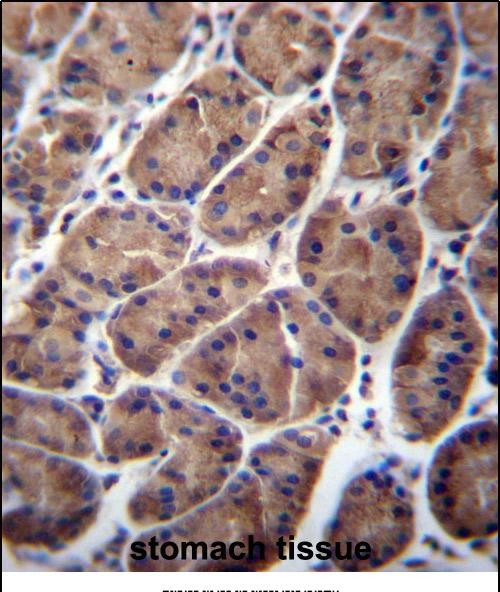PFDN5 Antibody (Center)
Affinity Purified Rabbit Polyclonal Antibody (Pab)
- SPECIFICATION
- CITATIONS
- PROTOCOLS
- BACKGROUND

Application
| IHC-P, WB, E |
|---|---|
| Primary Accession | Q99471 |
| Other Accession | Q9WU28, Q8HYI9, NP_002615.2 |
| Reactivity | Human, Mouse |
| Predicted | Bovine |
| Host | Rabbit |
| Clonality | Polyclonal |
| Isotype | Rabbit IgG |
| Calculated MW | 17328 Da |
| Antigen Region | 79-108 aa |
| Gene ID | 5204 |
|---|---|
| Other Names | Prefoldin subunit 5, C-Myc-binding protein Mm-1, Myc modulator 1, PFDN5, MM1, PFD5 |
| Target/Specificity | This PFDN5 antibody is generated from rabbits immunized with a KLH conjugated synthetic peptide between 79-108 amino acids from the Central region of human PFDN5. |
| Dilution | IHC-P~~1:10~50 WB~~1:1000 E~~Use at an assay dependent concentration. |
| Format | Purified polyclonal antibody supplied in PBS with 0.09% (W/V) sodium azide. This antibody is purified through a protein A column, followed by peptide affinity purification. |
| Storage | Maintain refrigerated at 2-8°C for up to 2 weeks. For long term storage store at -20°C in small aliquots to prevent freeze-thaw cycles. |
| Precautions | PFDN5 Antibody (Center) is for research use only and not for use in diagnostic or therapeutic procedures. |
| Name | PFDN5 |
|---|---|
| Synonyms | MM1, PFD5 |
| Function | Binds specifically to cytosolic chaperonin (c-CPN) and transfers target proteins to it. Binds to nascent polypeptide chain and promotes folding in an environment in which there are many competing pathways for nonnative proteins. Represses the transcriptional activity of MYC. |
| Cellular Location | [Isoform 1]: Nucleus. [Isoform 3]: Nucleus. |
| Tissue Location | Highly expressed in pancreas and skeletal muscle and moderately in other tissues |

Thousands of laboratories across the world have published research that depended on the performance of antibodies from Abcepta to advance their research. Check out links to articles that cite our products in major peer-reviewed journals, organized by research category.
info@abcepta.com, and receive a free "I Love Antibodies" mug.
Provided below are standard protocols that you may find useful for product applications.
Background
This gene encodes a member of the prefoldin alpha subunit family. The encoded protein is one of six subunits of prefoldin, a molecular chaperone complex that binds and stabilizes newly synthesized polypeptides, thereby allowing them to fold correctly. The complex, consisting of two alpha and four beta subunits, forms a double beta barrel assembly with six protruding coiled-coils. The encoded protein may also repress the transcriptional activity of the proto-oncogene c-Myc. Alternatively spliced transcript variants encoding different isoforms have been described. [provided by RefSeq].
References
Ma, H.C., et al. J. Biomed. Sci. 15(4):417-425(2008)
Yoshida, T., et al. Exp. Cell Res. 314(6):1217-1228(2008)
Lubyova, B., et al. J. Biol. Chem. 282(44):31944-31953(2007)
Hagio, Y., et al. J. Cell. Biochem. 97(1):145-155(2006)
Bruneel, A., et al. Proteomics 5(15):3876-3884(2005)
If you have used an Abcepta product and would like to share how it has performed, please click on the "Submit Review" button and provide the requested information. Our staff will examine and post your review and contact you if needed.
If you have any additional inquiries please email technical services at tech@abcepta.com.













 Foundational characteristics of cancer include proliferation, angiogenesis, migration, evasion of apoptosis, and cellular immortality. Find key markers for these cellular processes and antibodies to detect them.
Foundational characteristics of cancer include proliferation, angiogenesis, migration, evasion of apoptosis, and cellular immortality. Find key markers for these cellular processes and antibodies to detect them. The SUMOplot™ Analysis Program predicts and scores sumoylation sites in your protein. SUMOylation is a post-translational modification involved in various cellular processes, such as nuclear-cytosolic transport, transcriptional regulation, apoptosis, protein stability, response to stress, and progression through the cell cycle.
The SUMOplot™ Analysis Program predicts and scores sumoylation sites in your protein. SUMOylation is a post-translational modification involved in various cellular processes, such as nuclear-cytosolic transport, transcriptional regulation, apoptosis, protein stability, response to stress, and progression through the cell cycle. The Autophagy Receptor Motif Plotter predicts and scores autophagy receptor binding sites in your protein. Identifying proteins connected to this pathway is critical to understanding the role of autophagy in physiological as well as pathological processes such as development, differentiation, neurodegenerative diseases, stress, infection, and cancer.
The Autophagy Receptor Motif Plotter predicts and scores autophagy receptor binding sites in your protein. Identifying proteins connected to this pathway is critical to understanding the role of autophagy in physiological as well as pathological processes such as development, differentiation, neurodegenerative diseases, stress, infection, and cancer.




